ELECTRIC VEHICLE: charging
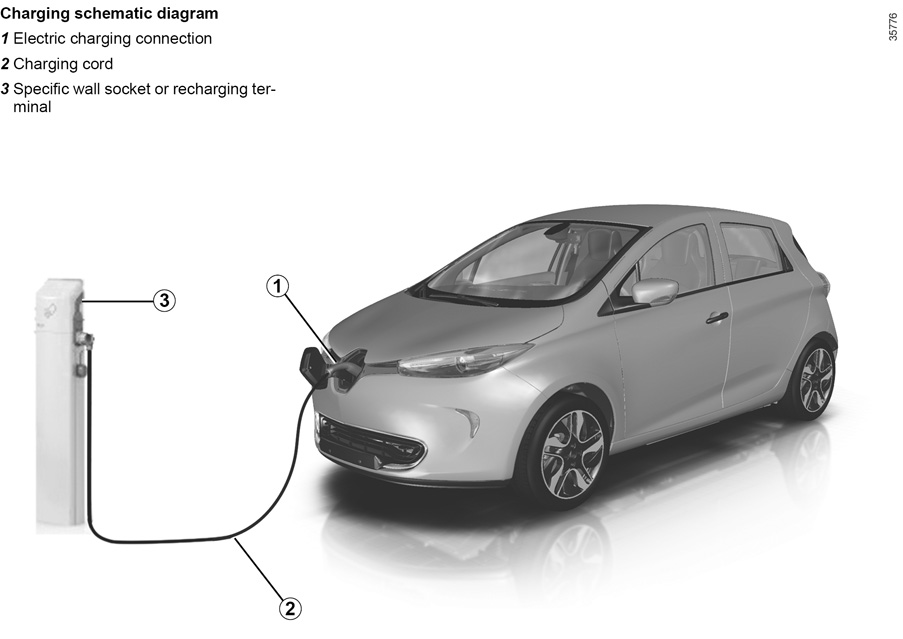
If you have any questions regarding the equipment needed for charging, please ask an authorised dealer.
Important recommendations for charging your vehicle
Please read these instructions carefully. Failure to follow these instructions may lead to a risk of fire, serious injury or electric shocks which could result in death.
Charging
Do not do anything to the vehicle during charging (washing, working in the engine compartment, etc.).
In the event of the presence of water, signs of corrosion or foreign bodies in the charging cord connector or in the vehicle charging socket, do not charge the vehicle. Fire hazard.
Do not attempt to touch the cord contacts, the domestic socket or the vehicle charging socket, or introduce objects into them.
Never plug the charging cord into an adapter, multiple socket or extension lead.
The use of generators is prohibited.
Do not remove or change the vehicle charging socket or the charging cord. Fire hazard.
Do not modify or perform any action on the installation during charging.
In the event of an impact, even slight, against the charging socket or valve, have them checked by an authorised dealer as soon as possible.
Take care of the cord: do not tread on it, immerse it in water or pull on it or let anything knock against it.
Check regularly that the charging cord is in good condition.
Do not use in the event of any damage to the charging cord (corrosion, discolouring, cuts, etc.) or to the unit. Please see an authorised dealer for a replacement.
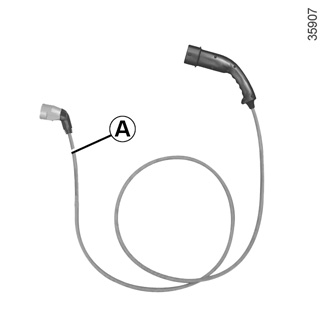

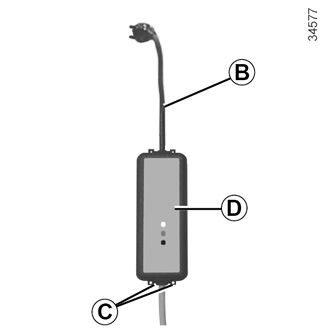
Charging cord A
This cord, designed for specific wall sockets or public terminals, enables the standard charge of the traction battery.
Charging cord B
This cord allows:
- standard charge, on a socket used only for the vehicle (14A / 16A charge);
- occasional charge using a domestic socket, when you are not at home, for example (10A charge).
Sockets must be fitted as stated in the instructions in the instructions supplied with the charging cord B.
Always read the charging cord instructions carefully before using it B.
We recommend that you use a charging cord that enables a standard charge to charge the traction battery.
Each charging cord is stored in a bag in the boot of the vehicle.
Never leave the socket hanging by the cord. Use the hooks C to attach it.
If a charging cord malfunctions during the charging process (red warning light on the unit D), stop charging immediately. Please refer to the cord instructions.
Important recommendations for charging your vehicle
Please read these instructions carefully. Failure to follow these instructions may lead to a risk of fire, serious injury or electric shocks which could result in death.
Choice of charging cord
The standard charging cords supplied with the vehicle have been designed specifically for this vehicle. It is designed to protect you against the risks of electric shock that can lead to death or fire.
For safety reasons, the use of a charging cord not recommended by the manufacturer is strictly forbidden. Failure to follow this instruction can lead to risks of fire or electric shock that can prove fatal. For information on a charging cord suited to your vehicle, please consult an authorised dealer.
Installation
For a standard charge
- Using the charging cord A
Have a special wall socket installed by a qualified professional.
- Using the charging cord B
The socket used to charge electric vehicles (14A / 16A charge) must be fitted by a qualified professional. Read the instructions provided with this product carefully.
For occasional charging (charging cord B)
With a domestic socket (10A charge)
Have a professional check that each socket to which you intend to connect the charging cord complies with the standards and regulations in force in your country.
Please read the instructions that come with the charging cord carefully to learn about precautions you must take when using the product and the technical specifications required when fitting the socket.
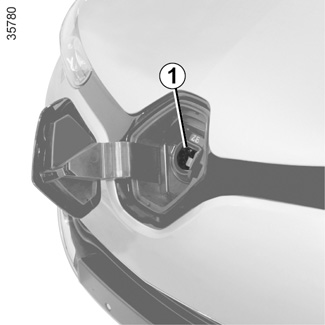
Electric charging connection 1
Note: If in a snowy environment, remove snow from the vehicle charging area before plugging in or disconnecting. Snow in the socket may block the insertion of the charging cord plug.
The vehicle has a charging connection located at the front of the vehicle.
Avoid charging and parking your vehicle in extreme temperatures (hot or cold).
Under extreme conditions, charging may take several minutes before starting (time required for the traction battery to cool down or warm up).
When the vehicle is parked for more than seven days in temperatures below about -25°C, charging the traction battery can become impossible.
When the vehicle is parked for more than three months with near zero charge, charging the battery can become impossible.
To preserve the service life of your traction battery, avoid parking the vehicle for more than one month with high charge, especially when the weather is very hot.
Favour charging the traction battery after driving and/or in mild temperatures. Otherwise, charging may take a longer period of time or even become impossible.
Recommendations
- In high temperatures, try to park and recharge the vehicle in a shaded/covered location.
- Charging can be performed in the rain or snow.
- Activating the air-conditioning increases the charge duration period.
In the absence of any protection against overvoltage, you are recommended not to charge the vehicle in stormy weather (lightning, etc).

Recharging the traction battery
With the vehicle stationary, ignition off and gear lever in position P:
- take the charging cord located in the boot of your vehicle;
- remove it from its storage bag;
- plug in the end of the cord to the power supply;
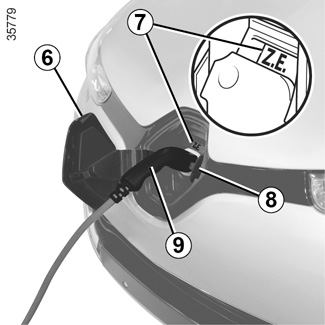
- press the button 5 on the RENAULT card or on the switch 4 to unlock the charging flap 6.
On the instrument panel, a red warning light 10 comes on and the Z.E. warning light 7 comes on in blue;
- open valve 8;
- grab the handle 9;
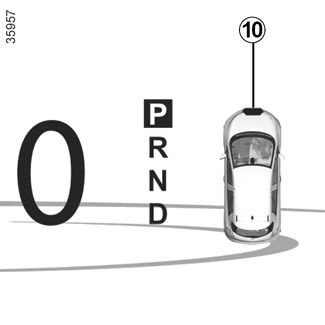
- plug in the vehicle cord. The Z.E. warning light 7 flashes rapidly;
- after you hear a locking click, check that the charging cord is properly plugged in. To check the locking, pull gently on the handle 9.
The charging cord is automatically locked with the vehicle. This will make it impossible to unplug the cord from your vehicle.
Do not use an extension lead, multiple socket or adapter.
Fire hazard.
Make sure you fully uncoil the charging cord to limit its heating.

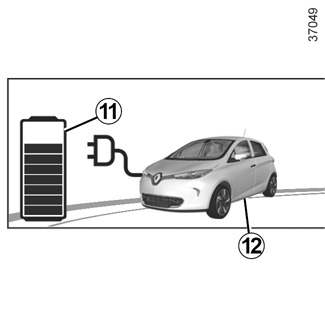
During charging, the Z.E. warning light 7 slowly flashes blue.
During charging, the following information is displayed on the instrument panel:
- the energy level on the battery warning light 11;
- the battery refill rate;
- an estimate of the remaining charging time (this is not displayed after about 95% charge);
- the instrument panel background flashes blue;
- the warning light 12 indicates that the vehicle is connected to a power supply.
At the end of a full charge, the Z.E. warning light 7 will remain blue. After a few seconds, the whole display switches off on the instrument panel.
You do not need to wait until the charge is at reserve levels to recharge your vehicle.
Operating fault
Impossible to charge the battery
This can be due to charging programmed at a time that conflicts with your instantaneous load demand.
Cancel the charging programming (refer to the information on “Electric vehicle: charging programming” in Section 1).
If no charge is programmed, contact an authorised dealer.
The traction battery charging time depends on the amount of energy remaining and the power delivered by the charging terminal. The information is displayed on the instrument panel during charging. Please see the information on “Displays and indicators” in Section 1.
In the event of a problem, we recommend that you replace it with an identical cord. Please see an authorised dealer.
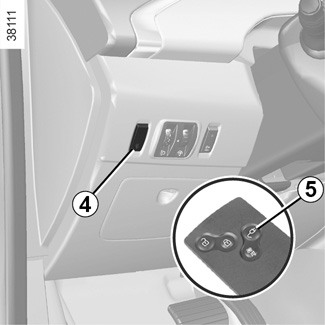
Precautions to take when removing from the socket
- Press the button 5 on the RENAULT card or press the switch 4 to unlock the vehicle charging cord;
- grab the handle 9;
It is imperative to follow the unplugging steps in order.

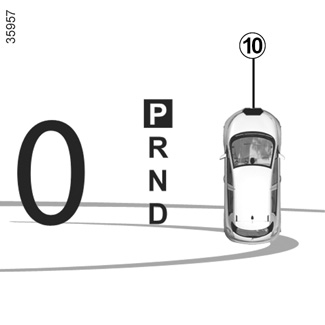
- unplug the charging cord from the vehicle;
- the valve 8 must be closed;
- the charging flap 6 must be closed. Press down to lock it. The red warning light 10 on the instrument panel goes off;
- unplug the cord from the power supply;
- store the cord in its storage bag and put away in the boot.
Note: immediately after a long charge of the traction battery, the cable may be hot. Please use the handles.
After pressing the charging cord unlocking button, you have 30 seconds to unplug it before it locks again.
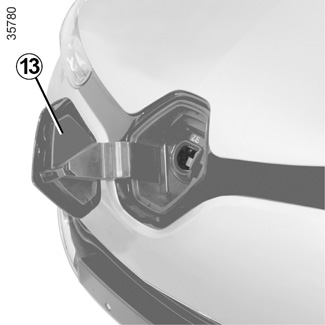
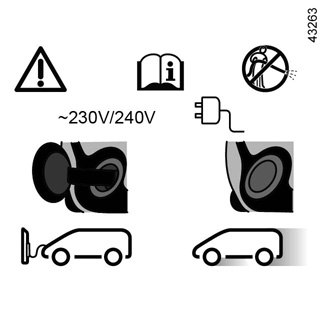
Label 13
The label 13 on the charging flap reminds you of the instructions for the opening and closing of the flap:
- with the vehicle stationary, the valve and the charging flap can be open;
- when the vehicle is being driven, the valve and the charging flap must be closed.
To avoid disturbing the charging monitoring system, do not install any antistatic strip to the vehicle.